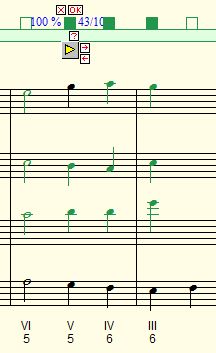

- #HARMONY ASSISTANT CHANGE QUARTER REST SYMBOL VERIFICATION#
- #HARMONY ASSISTANT CHANGE QUARTER REST SYMBOL PLUS#
9 (1906) displays quartal harmony: the first measure and a half construct a five-part fourth chord with the notes (highlighted in red in the illustration) A–D ♯–F–B ♭–E ♭–A ♭ distributed over the five stringed instruments (the viola must tune down the lowest string by a minor third, and read in the unfamiliar tenor clef). Schoenberg Īrnold Schoenberg's Chamber Symphony Op. Paul Dukas's The Sorcerer's Apprentice (1897) has a rising repetition in fourths, as the tireless work of out-of-control walking brooms causes the water level in the house to "rise and rise".Ģ0th- and 21st-century classical music Ĭomposers who use the techniques of quartal harmony include Claude Debussy, Francis Poulenc, Alexander Scriabin, Alban Berg, Leonard Bernstein, Arnold Schoenberg, Igor Stravinsky, Joe Hisaishi and Anton Webern.

In France, Erik Satie experimented with planing in the stacked fourths (not all perfect) of his 1891 score for Le Fils des étoiles. Scriabin's sketches for his unfinished work Mysterium show that he intended to develop the Mystic chord into a huge chord incorporating all twelve notes of the chromatic scale. Scriabin wrote this chord in his sketches alongside other quartal passages and more traditional tertian passages, often passing between systems, for example widening the six-note quartal sonority (C–F ♯–B ♭–E–A–D) into a seven-note chord (C–F ♯–B ♭–E–A–D–G). 6.Īudio playback is not supported in your browser. Scriabin used a self-developed system of transposition using fourth-chords, like his Mystic chord (shown below) in his Piano Sonata No. Wagner's unusual chord is really a device to draw the listener into the musical-dramatic argument which the composer is presenting to us.Īt the beginning of the 20th century, quartal harmony finally became an important element of harmony.
#HARMONY ASSISTANT CHANGE QUARTER REST SYMBOL PLUS#
ĭespite the layering of fourths, it is rare to find musicologists identifying this chord as "quartal harmony" or even as "proto-quartal harmony", since Wagner's musical language is still essentially built on thirds, and even an ordinary dominant seventh chord can be laid out as augmented fourth plus perfect fourth (F–B–D–G).

18, but Wagner's use was significant, first because it is seen as moving away from traditional tonal harmony and even towards atonality, and second because with this chord Wagner actually provoked the sound or structure of musical harmony to become more predominant than its function, a notion which was soon after to be explored by Debussy and others. The chord had been found in earlier works, notably Beethoven's Piano Sonata No. This layering of fourths in this context has been seen as highly significant. The bottom two notes make up an augmented fourth, while the upper two make up a perfect fourth. For instance, the quartal chord, C–F–B ♭, can be written as

Like tertian chords, a given quartal or quintal chord can be written with different voicings, some of which obscure its quartal structure. Because of this relationship, any quartal chord can be rewritten as a quintal chord by changing the order of its pitches. Quintal harmony (the harmonic layering of fifths specifically) is a lesser-used term, and since the fifth is the inversion or complement of the fourth, it is usually considered indistinct from quartal harmony.
#HARMONY ASSISTANT CHANGE QUARTER REST SYMBOL VERIFICATION#
The indifference of this rootless harmony to tonality places the burden of key verification upon the voice with the most active melodic line. Regarding chords built from perfect fourths alone, composer Vincent Persichetti writes that:Ĭhords by perfect fourth are ambiguous in that, like all chords built by equidistant intervals ( diminished seventh chords or augmented triads), any member can function as the root. Listeners familiar with music of the European common practice period perceive tonal music as that which uses major and minor chords and scales, wherein both the major third and minor third constitute the basic structural elements of the harmony. Use of the terms quartal and quintal arises from a contrast, compositional or perceptual, with traditional tertian harmonic constructions. Notes in a quartal chord on A can be arranged to form a thirteenth chord on B ♭.


 0 kommentar(er)
0 kommentar(er)
